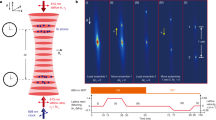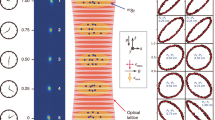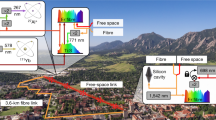Abstract
Comparisons of high-accuracy optical atomic clocks1 are essential for precision tests of fundamental physics2, relativistic geodesy3,4,5 and the anticipated redefinition of the second by the International System of Units6. The scientific reach of these applications is restricted by the statistical precision of comparison measurements between clocks realized with different atomic species. The instability of individual clocks is limited by the finite coherence time of the optical local oscillator, which bounds the maximum atomic interrogation time. Here we experimentally demonstrate differential spectroscopy7, a comparison protocol that enables interrogating times beyond the optical local oscillator coherence time. By phase coherently linking a zero-dead-time8 Yb optical lattice clock with an Al+ single-ion clock via an optical frequency comb and performing synchronized Ramsey spectroscopy, we show an improvement in comparison instability relative to previous results9 of nearly an order of magnitude. This result represents one of the most stable interspecies clock comparisons to date.
This is a preview of subscription content, access via your institution
Access options
Access Nature and 54 other Nature Portfolio journals
Get Nature+, our best-value online-access subscription
$29.99 / 30 days
cancel any time
Subscribe to this journal
Receive 12 print issues and online access
$209.00 per year
only $17.42 per issue
Buy this article
- Purchase on Springer Link
- Instant access to full article PDF
Prices may be subject to local taxes which are calculated during checkout




Similar content being viewed by others
Data availability
All the supporting data are available from the corresponding authors upon reasonable request.
References
Ludlow, A. D., Boyd, M. M., Ye, J., Peik, E. & Schmidt, P. O. Optical atomic clocks. Rev. Mod. Phys. 87, 637 (2015).
Safronova, M. S. et al. Search for new physics with atoms and molecules. Rev. Mod. Phys. 90, 025008 (2018).
McGrew, W. F. Atomic clock performance enabling geodesy below the centimetre level. Nature 564, 87–90 (2018).
Grotti, J. Geodesy and metrology with a transportable optical clock. Nat. Phys. 14, 437–441 (2018).
Delva, P., Denker, H. & Lion, G. in Relativistic Geodesy: Foundations and Applications (eds. Puetzfeld, D. & Lammerzahl, C.) 25–86 (Springer, 2019).
Riehle, F., Gill, P., Arias, F. & Robertsson, L. The CIPM list of recommended frequency standard values: guidelines and procedures. Metrologia 55, 188 (2018).
Hume, D. B. & Leibrandt, D. R. Probing beyond the laser coherence time in optical clock comparisons. Phys. Rev. A 93, 032138 (2016).
Schioppo, M. Ultrastable optical clock with two cold-atom ensembles. Nat. Photon. 11, 48–52 (2017).
Network, B. A. C. O. Frequency ratio measurements at 18-digit accuracy using an optical clock network. Nature 591, 564–569 (2021).
Brewer, S. M. et al. 27Al+ quantum-logic clock with a systematic uncertainty below 10−18. Phys. Rev. Lett. 123, 033201 (2019).
Bothwell, T. et al. JILA SrI optical lattice clock with uncertainty of 2.0 × 10−18. Metrologia 56, 065004 (2019).
Huang, Y. et al. A liquid nitrogen-cooled Ca+ optical clock with systematic uncertainty of 3 × 10−18. Phys. Rev. Appl. 17, 034041 (2022).
Huntemann, N., Sanner, C., Lipphardt, B., Tamm, C. & Peik, E. Single-ion atomic clock with 3 × 10−18 systematic uncertainty. Phys. Rev. Lett. 116, 063001 (2016).
Lange, R. et al. Improved limits for violations of local position invariance from atomic clock comparisons. Phys. Rev. Lett. 126, 011102 (2021).
Derevianko, A. Atomic clocks and dark matter signatures. J. Phys.: Conf. Ser. 723, 012043 (2016).
Kozlov, M. G., Safronova, M. S., Crespo López-Urrutia, J. R. & Schmidt, P. O. Highly charged ions: optical clocks and applications in fundamental physics. Rev. Mod. Phys. 90, 045005 (2018).
Chou, C. W. et al. Frequency-comb spectroscopy on pure quantum states of a single molecular ion. Science 367, 1458–1461 (2020).
Banerjee, A., Kim, H., Matsedonskyi, O., Perez, G. & Safronova, M. S. Probing the relaxed relaxion at the luminosity and precision frontiers. J. High Energ. Phys. 2020, 153 (2020).
Leroux, I. D. et al. On-line estimation of local oscillator noise and optimisation of servo parameters in atomic clocks. Metrologia 54, 307 (2017).
Bize, S. et al. Interrogation oscillator noise rejection in the comparison of atomic fountains. IEEE Trans. Ultrason., Ferroelectr., Freq. Control 47, 1253–1255 (2000).
Takamoto, M. Frequency ratios of Sr, Yb, and Hg based optical lattice clocks and their applications. C. R. Phys. 16, 489–498 (2015).
Chwalla, M. et al. Precision spectroscopy with two correlated atoms. Appl. Phys. B 89, 483–488 (2007).
Clements, E. R. et al. Lifetime-limited interrogation of two independent 27Al+ clocks using correlation spectroscopy. Phys. Rev. Lett. 125, 243602 (2020).
Borregaard, J. & Sørensen, A. S. Efficient atomic clocks operated with several atomic ensembles. Phys. Rev. Lett. 111, 090802 (2013).
Kohlhaas, R. et al. Phase locking a clock oscillator to a coherent atomic ensemble. Phys. Rev. X 5, 021011 (2015).
Bowden, W., Vianello, A., Hill, I. R., Schioppo, M. & Hobson, R. Improving the Q factor of an optical atomic clock using quantum nondemolition measurement. Phys. Rev. X 10, 041052 (2020).
Dörscher, S. et al. Dynamical decoupling of laser phase noise in compound atomic clocks. Commun. Phys. 3, 185 (2020).
Rosenband, T. Frequency ratio of Al+ and Hg+ single-ion optical clocks; metrology at the 17th decimal place. Science 319, 1808–1812 (2008).
Nemitz, N. et al. Frequency ratio of Yb and Sr clocks with 5 × 10−17 uncertainty at 150 seconds averaging time. Nat. Photon. 10, 258–261 (2016).
Dörscher, S. et al. Optical frequency ratio of a 171Yb+ single-ion clock and a 87Sr lattice clock. Metrologia 58, 015005 (2021).
Schmidt, P. O. et al. Spectroscopy using quantum logic. Science 309, 749–752 (2005).
Leopardi, H. et al. Single-branch Er:fiber frequency comb for precision optical metrology with 10−18 fractional instability. Optica 4, 879–885 (2017).
Briles, T. C., Yost, D. C., Cingöz, A., Ye, J. & Schibli, T. R. Simple piezoelectric-actuated mirror with 180 kHz servo bandwidth. Opt. Express 18, 9739–9746 (2010).
Dick, G. J., Prestage, J. D., Greenhall, C. A. & Maleki, L. In Proc. 22nd Annual Precise Time and Time Interval Systems and Applications Meeting 487–508 (NASA, 1990).
Ma, L.-S., Jungner, P., Ye, J. & Hall, J. L. Delivering the same optical frequency at two places: accurate cancellation of phase noise introduced by an optical fiber or other time-varying path. Opt. Lett. 19, 1777–1779 (1994).
Fortier, T. M., Bartels, A. & Diddams, S. A. Octave-spanning Ti:sapphire laser with a repetition rate >1 GHz for optical frequency measurements and comparisons. Opt. Lett. 31, 1011–1013 (2006).
Beloy, K. et al. Atomic clock with 1 × 10−18 room-temperature blackbody Stark uncertainty. Phys. Rev. Lett. 113, 260801 (2014).
Acknowledgements
We thank R. C. Brown and C.-W. Chou for their careful reading and feedback on this manuscript. We also acknowledge contributions from P. Rich, in carrying out a characterization of the magnetic field noise of the Yb system. This work was supported by the National Institute of Standards and Technology (NIST), the Defense Advanced Research Projects Agency (Atomic-Photonic Integration Program), the National Science Foundation Q-SEnSE Quantum Leap Challenge Institute (grant no. 2016244) and the Office of Naval Research (grant nos. N00014-18-1-2634 and N00014-20-1-2431). M.E.K. was supported by an appointment to the Intelligence Community Postdoctoral Research Fellowship Program at NIST administered by ORISE through an interagency agreement between the DOE and ODNI. H.L. was supported by the Department of Defense (DoD) through the National Defense Science and Engineering Graduate (NDSEG) Fellowship Program. The views, opinions and/or findings expressed are those of the authors and should not be interpreted as representing the official views or policies of the Department of Defense or the US government.
Author information
Authors and Affiliations
Contributions
All the authors contributed to the design of the experiment, collection of data and revision of the manuscript. During the measurements, Al+ clock operation was conducted by E.R.C., D.B.H., M.E.K., D.R.L. and J.L.V. Yb clock operation was conducted by W.F.M., Y.S.H., X.Z. and A.D.L. Comb metrology laboratory operation was conducted by T.M.F., H.L. and N.V.N. Data analysis and preparation of the manuscript were performed by M.E.K., D.R.L., W.F.M. and N.V.N.
Corresponding authors
Ethics declarations
Competing interests
The authors declare no competing interests.
Peer review
Peer review information
Nature Physics thanks the anonymous reviewers for their contribution to the peer review of this work.
Additional information
Publisher’s note Springer Nature remains neutral with regard to jurisdictional claims in published maps and institutional affiliations.
Extended data
Extended Data Fig. 1 Frequency comb optical path.
Optical paths surrounding the optical frequency comb portion of the experiment that enables coherent transfer of phase between the Yb and Al+ clocks.
Extended Data Fig. 2 An optimized zero-dead-time clock.
(a) The timing sequence for a ZDT clock with a variable delay between the π/2-pulses. Note that the length of each step is not to scale. (b) Displayed is the sensitivity function for a zero- dead-time sequence in which the Ramsey pulses of the two atomic systems are precisely overlapped (red) or offset from each other by 27.73% (green). The sensitivity functions have been vertically offset from each other for visual clarity. (c) The optimal delay is determined by calculating the one-second Dick instability for a variable delay between the two pulses. These calculations assume the OLO noise is flicker-frequency and at the level of 1.5 × 10-16. The blue line demonstrates that the Dick instability exhibits a sharply defined minimum. We emphasize that the Dick instability reported here would be added in quadrature with other sources of instability, such as atomic detection noise and quantum-projection noise, which under current conditions would limit the total clock instability at a level at least an order of magnitude higher than the calculated Dick instability. The red and green dots represent the conditions with overlapping Ramsey pulses and optimized timing, respectively.
Extended Data Fig. 3 Instability added by phase-stabilized fibre network.
The Al+ clock OLO, which is locked to the Yb clock OLO through the Er/Yb:glass frequency comb, and the Yb clock OLO are compared with a Ti:Sapphire frequency comb. The top figure shows the histogram of the frequency noise, and the bottom shows the Allan deviation plot.
Extended Data Fig. 4 Results of the simulations that vary the noise sources in the operation of the ZDT di erential spectroscopy operation.
The top panel shows the contrast in the phase scan of the Al+ clock, and the bottom shows the Allan deviation plot for: when only the OLO noise is present (yellow line), when OLO and the magnetic field noise sources are present (orange line), and when OLO, magnetic field, and the fibre link noises are present (blue line). The green dashed line in the bottom panel indicates the QPN limit.
Extended Data Fig. 5 Example of the data analysis used to determine the long-averaging-time asymptotic Allan deviation.
This data set is Ramsey spectroscopy of the Al+ clock without any feedforward corrections from Yb, at a interrogation time of 454 ms. The top panel shows the time series of the measured Al+ transition frequency relative to the Yb stabilized OLO. The middle left panel shows the corresponding power spectral density of frequency noise, which is fit to the function \({S}_{w}/(1+{(f/{f}_{c})}^{2})\). The t residuals are shown at the bottom of this panel. The middle right panel shows χ2 as a function of the two t parameters. The red dotted line is a contour of constant \({\chi }^{2}=\min ({\chi }^{2})+1\), and the black dashed lines are the 68% confidence interval bounds for the fit parameter Sw. The bottom panel shows the Allan deviation of the frequency data (blue circles) and the long-averaging-time asymptotic Allan deviation corresponding to the Sw fit parameter (red line and shaded confidence interval).
Rights and permissions
Springer Nature or its licensor holds exclusive rights to this article under a publishing agreement with the author(s) or other rightsholder(s); author self-archiving of the accepted manuscript version of this article is solely governed by the terms of such publishing agreement and applicable law.
About this article
Cite this article
Kim, M.E., McGrew, W.F., Nardelli, N.V. et al. Improved interspecies optical clock comparisons through differential spectroscopy. Nat. Phys. 19, 25–29 (2023). https://doi.org/10.1038/s41567-022-01794-7
Received:
Accepted:
Published:
Issue Date:
DOI: https://doi.org/10.1038/s41567-022-01794-7
This article is cited by
-
A lab-based test of the gravitational redshift with a miniature clock network
Nature Communications (2023)



